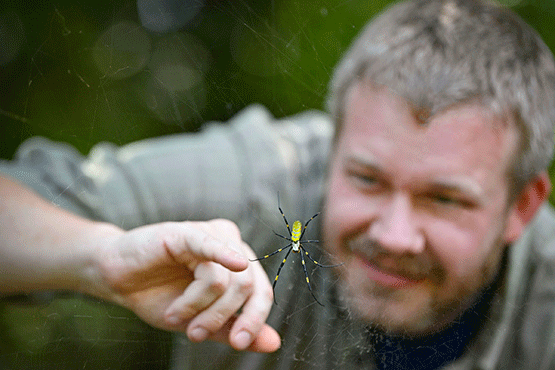news
Are Joro spiders an invasive species? Georgia Gwinnett College ecology expert says not quite yet

By Collin Elder
The sticky webs of Joro spiders are back in full force this fall, and it’s got scientists researching their nature as predators. Dr. Patrick Cain, a biology lecturer at Georgia Gwinnett College (GGC), discussed the potentially invasive species.
“While they’re not classified as invasive right now, I’d be surprised if that didn’t change soon,” said Cain.
He identified the criteria for an invasive species, saying that while the Joro ticks off several of the boxes on the list, they don’t hit enough of them to classify as invasive at this point. Some of the requirements for this classification are competition with endemic, or native, wildlife for resources like food and living space, how fast and the volume of their breeding cycle, and their ability to spread across the climate.
“Joros hit a lot of those criteria,” said Cain.
They’re moving up the eastern seaboard, with some sightings going as far north as North Carolina and Virginia. Last year, scientists thought that the cold of winter would work to quell the numbers of spiders that were effectively hibernating, as Joro don’t typically enjoy dry and cold weather, but the spider continues to grow in population.
Cain thinks that comes down to adaptability.
“Once a species learns to adapt to threats, they become much, much harder to deal with,” he said.
Joro are adapting to their new homes, and they’re learning to travel. The Joro is adept at spreading far due to their practice of “ballooning” where they use some of their silk to catch the wind, allowing them to travel for miles. Some have even been measured thousands of feet up with samples captured by airplanes.
The hardest part about classifying Joro as invasive, according to Cain, is that there isn’t evidence that they’re directly competing with golden orb weavers, their counterpart in Georgian ecology. Orb weavers reach their breeding cycle much earlier in the year compared to Joro spiders, meaning their need for resources happens before the nonnative species can get into gear to compete for them.
“Other invasive species in America, like the Burmese python in Florida, tend to spread uncontrollably until we interfere,” said Cain. He said there is an idea for curbing Joro population growth involve things like supporting natural predators that feed primarily on spiders, which can deal with the current situation, but may impact native life as well. Efforts in Guam to deal with the invasive brown tree snake involved feeding mice acetaminophen and dropping them in areas where their targets feed, poisoning the snakes. Joro, if classified as invasive, might need something just as drastic.
“I don’t know what direction they’re headed,” said Cain, “but I’m excited to see how the situation develops. Joro are an interesting part of the ecological puzzle, and we shouldn’t be afraid of them right now.”
Curbing local Joro populations with the practice of removing their webs, ideally with a broom handle, is the best way to deal with their presence. Knocking down webs will eventually teach the spiders to stay away from certain areas, and the broom acts as a safety tool. Though Joro are naturally skittish and aren’t extremely venomous, their bite can be uncomfortable, much like a bee sting.
“They’re not harmless, but they’re not harmful so far. I’d be surprised if we don’t revisit their impact on the ecology of the southern coastal states.”
